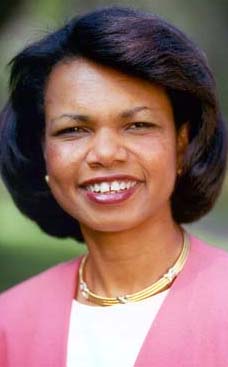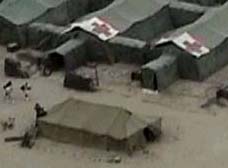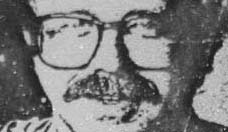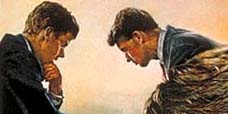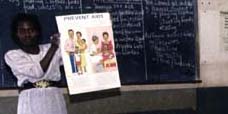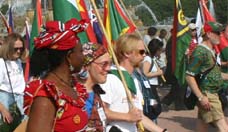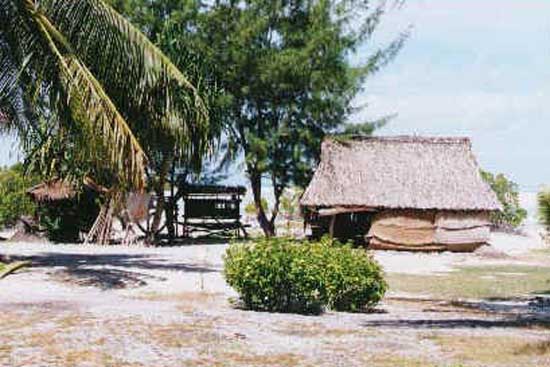
Here the writer reflects on the friendships between volunteers and locals. The cultural differences between Americans and I- Kiribati are often stark, and despite the ability of the volunteers to dress, eat, and sleep local style, the poem highlights the American sense of individualism and solitude in contrast to the Kiribati preference for communal life
Poem "Biitiko I" reflects on peace corps volunteers and citizens of Kiribati
Waa in Storms
Jan 1, 2006 - Contemporary Pacific
Waa in Storms, by Teweiariki Teaero. Suva: Institute of Pacific Studies, University of the South Pacific, 2004. ISBN 982-02-0368-6; xvi +114 pages, figures, photographs, appendixes, written in English and the Kiribati language, glossary. us$25.oo.
Waa in Storms (Canoe in Storms), Teweiariki Teaero's follow-up to his first anthology, On Eitei's Wings (2000), marks the growth of an important Pacific literary voice and visual artist. Teaero elegantly weaves together the poetic traditions of his home island nation, Kiribati (pronounced Kiribas), with those of the West and the "Niu" contemporary Pacific emerging from urban centers such as Suva in Fiji. Waa in Storms also grew out of a particularly challenging period in the author's life, and many of his pieces convey this turbulence.
The collection, containing a mixture of poetry, narrative, and nineteen ink-on-paper drawings, is divided into four "waves" or movements: "Pond Storms," "Lagoon Storms," "Ocean Storms," and "Calm again." The use of waves to represent time is a trademark of the Niu Waves Writers' Collective, based in Suva, of which Teaero is a long- term member. "Niu" is a pan-Pacific term for the coconut and an important symbol of cultural survival. The name of the collective is also a play on the word "new," reflecting the postcolonial, diasporic, globalizing Pacific (see also the drawing titled "Niu life" [66]).
Niu Waves regularly gathers at the Oceania Center for Arts and Culture at the University of the South Pacific, where Teaero is a lecturer in the department of education. The center's art exhibitions are often designated as particular "waves." Throughout Teaero's collection, one certainly gets the sense of rising and falling and rising again.
In his acknowledgments Teaero reveals that some of his writings are stories that others requested and so they are shared in the tradition of taan otooto, the composers of songs (ix). The composers are the poets and storytellers in Kiribati culture and Teaero straddles these roles in both the Western and traditional contexts. Half the poems are in "Kiribatese" (after "Gilbertese," ie, the Kiribati language) and the book is dedicated to three unimwane (male elders) and master orators-Taomati Nakibae Taramatang, Bauro Teteki, and Kiratanuea Teitawana.
While the overarching theme is one of tumult, it is Teaero's weaving of words and visual symbolism, his engagement with many sources of knowledge, and his obvious love and care for the process of learning and growing that, as the foreword indicates, keeps "fatal submersion" at bay (xv). Humor, celebration, and survival ply those waves of discontent. The writing and artwork are carefully laid out by graphic designer Mark Garrett so that the reader experiences a sense of turbulence, pause, reflection, and recovery in between visual and textual movements.
Waa in Storms begins, like any proper I-Kiribati event, with te katoka bau, a garlanding of the reader. This is offered visually through the image of Teaero's daughter, Itabero, moving to place the flowers on the reader's head. The first wave, "Pond Storms" (Buakan te nei), then reflects various phases of difficulty in Teaero's family life. The death of his father, a car accident that injured his youngest daughter, and feelings of loss, confusion, or insignificance particularly shape this section. He grounds his lament in the oceanic environment, in the journey of the waa or canoe, and in the return of te man te tangira, the "love bird" (22).
[Excerpt]
A piece in Kiribatese, "Biitiko I," reads as a letter to both a particular Peace Corps volunteer and to the corps in general (36- 38). Here the writer reflects on the friendships between volunteers and locals. The cultural differences between Americans and I- Kiribati are often stark, and despite the ability of the volunteers to dress, eat, and sleep local style, the poem highlights the American sense of individualism and solitude in contrast to the Kiribati preference for communal life. But in the short poem "Quiet Moments," the author seems grateful for the same solitude that earlier characterized Americans (40).





